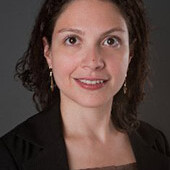Jessica Schneider, of the Belfer Center for Innovation and Social Impact at the 92nd Street Y in New York City, explains how and her team were responsible for spawning the global phenomenon of #GivingTuesday. Created in response to the annual shopping frenzy of "Cyber Monday," this day of charitable giving has been a success right from the start.
AMANDA GHANOONI: Hello. I am Amanda, program associate here at the Carnegie Council for Ethics in International Affairs. I'm with Jessica Schneider, the director of strategy and collaboration for the Belfer Center for Innovation and Social Impact at the 92nd Street Y (92Y), based here in New York City.
In 2012 she and her team were responsible for spawning the global phenomenon of #GivingTuesday, something that non-profits in private and public sectors have used to draw attention to various charity organizations. Thank you for joining us.
JESSICA SCHNEIDER: Thank you for having me, Amanda. I am happy to be here.
AMANDA GHANOONI: Can you first explain the 92nd Street Y and what the Belfer Center does?
JESSICA SCHNEIDER: Sure. The 92nd Street Y is a 140-plus-year-old organization on New York City's Upper East Side. We are everything you associate with a community center. We have a preschool and parenting programs. We have programs for seniors. We have a gym. We have arts classes.
We have an 800-seat theater and a 300-seat theater, and we have programming there every night, which is how a lot of people outside of our immediate neighborhood know us. We had 450 speakers and talks there last year. The 92nd Street Y has been an institution in New York City for a long time.
At the Belfer Center, what we're really charged with is thinking about 92Y's mission and how to scale it: so, ideas of building community, of ethics-based leadership, and of philanthropy; how do we take those ideas that infuse what we do at the 92nd Street Y every day and grow them, scale them beyond our neighborhood, beyond New York City, and globally.
To that end, we run a number of different programs. The first big program we launched, the centerpiece and what informs a lot of the work that we do, is #GivingTuesday.
AMANDA GHANOONI: Can you describe #GivingTuesday, how it began, and what it is exactly?
JESSICA SCHNEIDER: Sure. The idea behind #GivingTuesday is very simple. There are these two days, Black Friday and Cyber Monday, that do an amazing job of bringing together the retail community. In 2012 the 92nd Street Y, along with some partners, began to think through how we could bring the philanthropic community together in the same way to benefit the whole sector.
By "philanthropic community," we never meant just non-profits. We meant non-profits, for-profits, universities, foundations, schools, religious organizations, anyone thinking about making the world better—what if they had a day that could unite them?
So it started as just an idea: Wouldn't this be a cool thing to do? We spent the summer of 2012 going around and talking to different organizations across the spectrum, like that list I just described, plus other institutions that are very prominent in philanthropy, and getting ideas. We also talked to people outside the sector completely and got ideas from them.
As opposed to noodling on the idea for a year or two and trying to figure out how to launch it, we just went for it. So very quickly after we had the idea, we launched it. A couple of months before the first #GivingTuesday—I don't think I said this at the beginning, but it is the Tuesday after Thanksgiving, the day after Cyber Monday—we had an expectation of getting about a hundred organizations to commit to do something that day just to get us going. We ended up with 2,500 organizations that officially registered. Plus, on that day activities happened around the country that we didn't even know were going to happen until they did happen. So we knew right away that we were onto something.
The ask from the beginning was very simple of these organizations, companies, and schools: Just do something on that day to get your networks excited about giving, whether it's a corporation doing a matching campaign with their employees, a small business collecting donations at their—doing a soft drive—counter, a non-profit planning a volunteer event, or a teacher teaching a lesson about philanthropy—whatever you want to do, just do something that day to encourage giving in all its forms.
So that was 2012, our first year, and I'm going to jump ahead because a lot has happened during the course of the past five years. #GivingTuesday today is a global day of giving. It's hard for us to track everything that is happening that day—the limitations of data collection, and also it is now a movement, and it is hard to put parameters on that—but online giving this year that we could count was around $170 million, and we are sure that is just a small fraction of the total amount of online giving plus offline giving, which is great to see.
That is up about 44 percent from what we saw last year, and we know that it was the biggest day of giving in general for so many organizations—big organizations like Donors Choose, GlobalGiving, Stanford University, Hispanics in Philanthropy—but also the biggest day ever for tiny, community-run organizations all around the country.
But just taking a step to the side, it's about so much more than the giving that happens in monetary forms that day. I think what has been really exciting for us to see as the movement has grown is the volunteerism, the advocacy, the acts of kindness, and just how people use #GivingTuesday to really come together and support their communities on that day.
AMANDA GHANOONI: That's great. Do you know what it might look like in the next five years?
JESSICA SCHNEIDER: Five years is hard to say when you think about where we started from five years ago with it just being an idea and where we are now.
I do think there are certain elements of #GivingTuesday that are exciting for us to see. These are certain elements that have sprouted up organically over the last five years that we are really excited to see grow and at the 92nd Street Y we want to do our best to support. There are two in particular that come to mind.
One thing we're excited about is our community campaigns. Our first year in 2012 we had three community campaigns. These were cities, towns, states, and counties where non-profits and for-profits came together and tried to catalyze and organize around #GivingTuesday to run local campaigns, so Oregon Gives, Baltimore Gives, New York State Gives, sometimes with their own hashtag, sometimes with a central website.
The first year we had three; this year we had almost 90. It ranges from the City of Charlotte, which does a huge campaign with corporate sponsors—between fundraising, in-kind donations, and volunteer hours pledged, they said their overall impact was around $7 million—to Bethel, Alaska, which is a small town in westernmost Alaska with a coalition of about a dozen non-profits. On #GivingTuesday they worked with a local radio station around a promotion that they had, a community fair to highlight the great work of all the nonprofits. Bethel is so small that there is literally one three-way stop in the middle of town, and the different non-profits took turns all day standing outside with a boot collecting donations that were then split among all those local non-profits—
AMANDA GHANOONI: In November.
JESSICA SCHNEIDER: In Alaska.
AMANDA GHANOONI: Way below zero.
JESSICA SCHNEIDER: Late November in Alaska. So one element we're all excited about is the community campaigns. From the Charlottes to the Bethel, Alaskas, there is so much opportunity for communities to unite around the idea of #GivingTuesday as a moment to bring people together. It is not about individual organizations, though they benefit. It is about civic pride and civic participation.
Another thing we're really excited about thinking ahead—for the next one, two, five years, ten years, who knows?—is global participation. When we first started, we had no idea that other countries would be interested in #GivingTuesday, that it would click with them at all, especially since we spent the first or two thinking of it being so closely tied to Black Friday and Cyber Monday. But our first year, right away we saw activities happening globally around #GivingTuesday, and that has just continued to grow and grow. This year we had 98 countries that had some form of #GivingTuesday activity that we could track.
There were also 24 full-on #GivingTuesday country campaigns. These are places where an organization—like the 92nd Street Y—has stepped up to organize the entire country around a #GivingTuesday campaign.
The first one was in the United Kingdom, which makes sense—maybe they understand the American traditions a little bit more and have Cyber Monday and Black Friday—but now it is in places as varied as Tanzania, Brazil, and Russia. They are all running #GivingTuesday campaigns and they have #GivingTuesday websites, and they are working with their local governments and their local business leaders to create a grassroots movement. These are places that not only don't have a tradition around Thanksgiving, Black Friday, and Cyber Monday, but don't even have a tradition around philanthropy and giving, and are using the #GivingTuesday hook to start building that culture. So that has been amazing to see.
There is a WhatsApp group with all of the global leaders on it together. They talk every day. They share videos. When we made our #GivingTuesday public service announcement (PSA) for this year, we made a version without any voiceover and gave them a script so they were welcome to take it and make it their own if they wanted to.
The Brazilian PSA was amazing this year, so they made an English-language version, which we shared out to our community here in the States. As well, they share code to help build websites. It is very cool to see.
Looking ahead, I would love to see the global aspect of #GivingTuesday continue to grow and grow.
AMANDA GHANOONI: Absolutely. I don't use the word "phenomenon" lightly, but it seems like how it projected and where the growth has finally come and hopefully where it will be.
JESSICA SCHNEIDER: I do think, along those lines, one of the reasons it has connected with people is that it is such an open movement. But as I was saying at the beginning, there is no right or wrong way to participate in #GivingTuesday. There are definitely some best practices we try to share with the country leaders, but it is a day and a movement you can make your own.
AMANDA GHANOONI: Absolutely.
How important do you think social media was in all of this? You discussed a little bit about bringing communities together. Have you seen communities within the United States starting to forge and re-commune?
JESSICA SCHNEIDER: I think the social media side of things is very interesting. From the beginning, #GivingTuesday had a hashtag in its name. That was a very deliberate choice. From the beginning, thinking about social media, people online talk about what they ate for breakfast or share cute photos of their kids—which I am guilty of—but we have always believed that people want to have deeper conversations online.
I think since our beginning in 2012, we have seen that shift beginning to happen on everyone's news feeds of wanting to talk about more substantial issues, talk about what's important to them, and really define themselves through their social media. The causes you support and why you support them are part of that.
I believe that if you support an organization it is almost a moral imperative to tell people why you support that organization. A lot of religious traditions talk about giving anonymously, and I think there is great value in that. But there is also great value in saying, "I support this school, and this is why I support it and why I think you should support it as well." We know, based on the data, that the most powerful way to get someone to give is to share your own story about why you connect with an organization.
What I think is great about #GivingTuesday is not that people are just throwing the hashtag up on Twitter, but they're talking about what is important to them, what causes, what organizations, and I think that is really powerful.
AMANDA GHANOONI: I noticed on the website that you have this incredible blog with stories from all over the country and all over the world of people sharing how they gave and how their initiatives and projects are still living. They may have started at a small point, but for them they have grown to something very significant and probably something even more meaningful.
JESSICA SCHNEIDER: Exactly. Things like the blog are important to us because we don't have all the answers.
I think what's great about #GivingTuesday is when people in the community can talk to each other and share best practices. People are so creative around not just the day but how they use the day to spark year-round activity and how they use the day to tell the story of the work that they're doing. I love that we have been able to create a platform for people to share those experiences and help educate other organizations.
One other aspect of social media which has been very fun to see is how people have taken the hashtag #GivingTuesday and really made it their own. We also have a heart logo that people have made their own, changing the colors, doing different designs, putting it on mugs, and putting it on T-shirts. We love to see all of that.
But particularly on social media and the hashtag, from the first year people have been so creative with how they reinterpreted it around their organization, like #GivingShoesDay. Dress for Success every year runs a #GivingShoesDay campaign to get women to donate professional shoes to women who could use them for job interviews or at their first job.
This year we noticed a new #GivingShoesDay, and it was for an organization that does equine therapy for children with disabilities. So their #GivingShoesDay images were all horses getting new horseshoes.
I just love that because it has taken off and then taken off again, and there have been so many great examples of that. I can name a million of them, such as #GivingTreesDay.
#GivingBlueDay is also a great example. #GivingBlueDay is the University of Michigan, which has a wonderful campaign where they have their alumni, students, staff, and professors all acting as advocates for the university on that day. They empower them with toolkits and easy plug-and-play tools that on #GivingTuesday everyone is out talking about why they care about their school, why a scholarship or a sports team—whatever it might be—means a lot to them, and helps the University of Michigan tell their story by using their network, all under the umbrella of #GivingBlueDay.
A university like the University of Michigan has so many schools which are always separately fund-raising, so what is great about #GivingBlueDay and having that uniting hashtag is that they can come together collectively and tell a bigger story about everything that the university does.
AMANDA GHANOONI: Yes. So it is not just a generous community and a thoughtful community, but also a very creative community, too.
JESSICA SCHNEIDER: Exactly.
AMANDA GHANOONI: Thank you, Jessica, for joining us.
JESSICA SCHNEIDER: Thank you so much. I had a great time.



